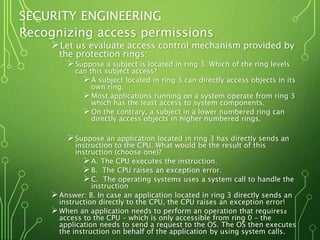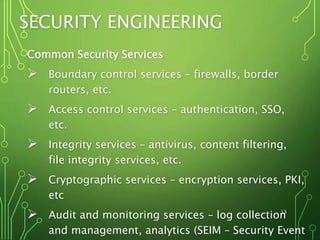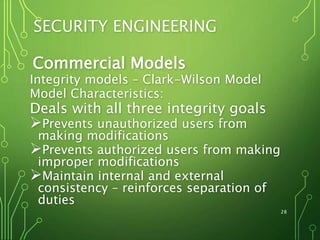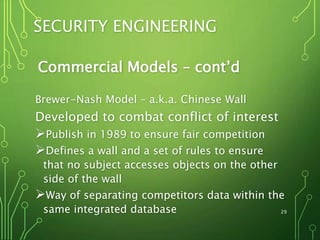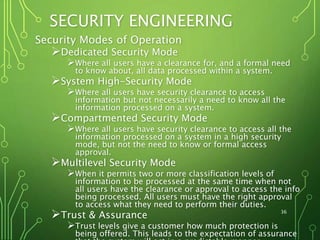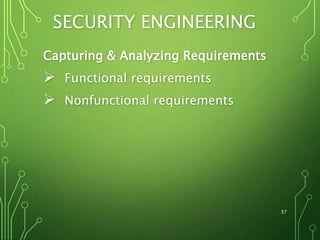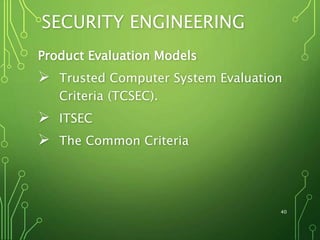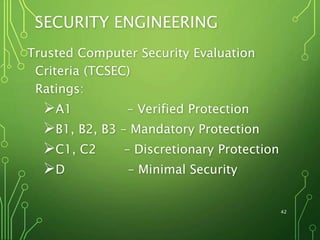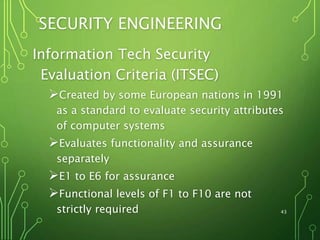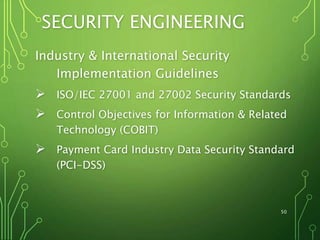CISSP Certification- Security Engineering-part1
- 1. SECURITY ENGINEERING Objectives of Domain: Understand the engineering lifecycle and apply security design principles. Understand the fundamental concepts of security models. Select controls and countermeasures based upon systems security standards. Assess and mitigate the vulnerabilities of security architectures, designs, and solution elements, mobile systems, and embedded devices. Apply cryptography Apply secure principles to site and facility design. 1
- 2. SECURITY ENGINEERING The Engineering Lifecycle Using Security Design principles Systems engineering models and processes usually organize themselves around the concept of lifecycle. Concept of operations Requirements Design Integration, Test, and Verification Verification and Validation Operation and Maintenance Retirement 2
- 3. SECURITY ENGINEERING Fundamental principles of Security Models Common system components Processors Memory and storage Primary storage Memory protection Secondary storage Virtual memory Firmware Peripherals and other I/O devices Operating system 3
- 4. SECURITY ENGINEERING • Security architecture is part of the overall architecture of an information system. It directs how the components included in the system architecture should be organized to ensure that security requirements are met. The security architecture of an information system should include: A description of the locations in the overall architecture where security measures should be placed. A description of how various components of the architecture should interact to ensure security. The security specifications to be followed when designing and developing the system. 4
- 5. SECURITY ENGINEERING Computer Architecture It comprises all the parts in a computer system that are necessary for it to function. Such parts include the operating system, memory chips, logic circuits, storage devices, I/O devices, security components, buses, and networking components. The Central Processing Unit (CPU) – Processes the instructions provided by the various applications/programs. To do this the CPU needs to access such instructions from their memory locations. The CPU can access the memory locations in its cache, along with memory locations in the random access memory (RAM). These types of memory are called primary memory. The major components. The Arithmetic Logic Unit (ALU) Control Unit (coordinates instruction execution) Registers that act as temporary memory locations and store the memory addresses of the instructions and data that needs processing by the CPU. 5
- 6. SECURITY ENGINEERING Computer Architecture Multiprocessing – more than one CPU Operating System Architecture Process Activity Memory Management Memory Types – RAM, ROM, etc. Virtual Memory CPU Modes & Protection Rings 6
- 7. SECURITY ENGINEERING CPU Modes & Protection rings Protection Rings provide a security mechanism for an operating system by creating boundaries between the various processes operating on a system and also ensures that processes do not affect each other or harm critical system components. Ring 0 – Operating system kernel (supervisor /privilege mode) Ring 1 – Remaining parts of the operating system (OS) Ring 2 – Operating system and I/O drivers and OS utilities Ring 3 – Applications (Programs) and user activity 7
- 8. SECURITY ENGINEERING Recognizing access permissions Let us evaluate access control mechanism provided by the protection rings: Suppose a subject is located in ring 3. Which of the ring levels can this subject access? A subject located in ring 3 can directly access objects in its own ring. Most applications running on a system operate from ring 3 which has the least access to system components. On the contrary, a subject in a lower numbered ring can directly access objects in higher numbered rings. Suppose an application located in ring 3 has directly sends an instruction to the CPU. What would be the result of this instruction (choose one)? A. The CPU executes the instruction. B. The CPU raises an exception error. C. The operating systems uses a system call to handle the instruction Answer: B. In case an application located in ring 3 directly sends an instruction directly to the CPU, the CPU raises an exception error! When an application needs to perform an operation that requires access to the CPU – which is only accessible from ring 0 – the application needs to send a request to the OS. The OS then executes the instruction on behalf of the application by using system calls. 8
- 9. SECURITY ENGINEERING Computer Architecture • Domains • Layering & Data Hiding • Virtual Machines • A virtual machine is a simulated real machine environment created to simultaneously run multiple applications on a computer. • Additional Storage Devices • Input/Output Device Management 9
- 10. SECURITY ENGINEERING • System Architecture Defined Subset of Subjects and Objects Trusted Computing Base (TCB) Originated from the Orange Book and deals with the protection mechanisms within a computer. It addresses hardware, software, and firmware. Security Perimeter It delineates the trusted and the untrusted components within a computer system. Reference Monitor The reference monitor is an abstract machine concept that mediates all access between subjects and objects. Security Kernel The Security kernel enforces the reference monitor concept. Must facilitate isolation of processes Must be invoked at every access attempt. Must be small enough to be tested and verified in a comprehensive manner. Security Policy – a set of rules on how resources are managed within a computer system. Least Privilege – one process has no more privileges than it needs. 10
- 11. SECURITY ENGINEERING • Security Models The function of a Security Model is to Map the abstract goals of a security policies to an information system. Specify mathematical formulae and data structures for implementing security policy goals. While a security policy states goals without specifying how to accomplish them, a security model specifies a framework to implement these goals. An organization can use different types of security models. However, it is very important for security personnel to understand the different security models to protect the organization’s resources. For example the security model that a military organization uses is quite different from that of a commercial entity, due to the variations in the types of data. Security Model can be formal when it is based on pure mathematical implementation of security policies and assure high security. For example in military systems, air controller systems, etc. Security Model is informal when it merely describes how to 11
- 12. SECURITY ENGINEERING Enterprise Security Architecture (ESA) Implements the building blocks of information security infrastructure across the entire organization. It focuses on a strategic design for a set of security services that can be leveraged by multiple applications, systems, or business processes Key goals and objectives of an ESA includes, Long term view of controls A unified vision for common security controls Leverages existing technology investments 12
- 13. SECURITY ENGINEERING Common Security Services Boundary control services – firewalls, border routers, etc. Access control services – authentication, SSO, etc. Integrity services – antivirus, content filtering, file integrity services, etc. Cryptographic services – encryption services, PKI, etc Audit and monitoring services – log collection and management, analytics (SEIM – Security Event 13
- 14. SECURITY ENGINEERING Security Zones of Control Area or grouping within which a defined set of security policies and measures are applied to achieve a specific level of security. Ensures that systems in a more secured zone do not leak through to a less secured zone. Zones are tightly controlled with mechanisms such as firewalls, authentication services, proxies, etc. 14
- 15. SECURITY ENGINEERING Common Architecture Frameworks An architecture framework is a structure that can further be used to develop a broad range of architectures. It describes a method of designing an integrated set of systems or system components. It may include a set of recommended standards and operational practices. 15
- 16. SECURITY ENGINEERING Zachman Framework Developed as a common context for understanding complex architectures. Allows for the communication and collaboration of all entities in the development of architectures. It provides a logical structure for integrating the plan, design, and build aspects of an architecture. 16
- 17. CISSP SECURITY ENGINEERING ASM EDUCATIONAL CENTER INC. (ASM) WHERE TRAINING, TECHNOLOGY & SERVICE CONVE RGE WWW.ASMED.COM PHONE: (301)984-7400 17
- 18. SECURITY ENGINEERING Sherwood Applied Business Security Architecture (SABSA) Framework A holistic lifecycle for developing a security architecture that considers business requirements. It creates a chain of traceability through the phases of strategy, concept, design, implementation, and metric. 18
- 19. SECURITY ENGINEERING The Open Group Architecture Framework (TOGAF) It is an open framework for organizations to design and build enterprise architectures. It provides an architecture development method that describes the step-by-step process. 19
- 20. SECURITY ENGINEERING IT Infrastructure Library (ITIL) Developed by the Central Computer and Telecommunications Agency (CCTA), an agency under the British Government. ITIL defines the organizational structure and skill requirements and operational procedures with practices that direct IT operations and infrastructure, including security. What sets ITIL apart is the strong focus on end-to-end service delivery and management. 20
- 21. SECURITY ENGINEERING Types of Security Models State Machine Model. Multilevel Lattice Model Non-interference Model Information Flow Model 21
- 22. SECURITY ENGINEERING •Security Models State Machine Models The Bell-LaPadula Model The Biba Model The Clark-Wilson Model The Brewer & Nash Model Take-Grant Model Access Control Matrix The Graham-Denning Model The Information Flow Model The Non-Interference Model The Harrison-Ruzzo-Ulman Model 22
- 23. SECURITY ENGINEERING Security Models State Machine Models The state of a system is its snapshot at any one particular moment. The state machine model describes subjects, objects, and sequences in a system. The focus of this model is to capture the system’s state and ensure its security. When an object accepts input, the value of the state variable is modified. For a subject to access this object or modify the object value, the subject should have appropriate access rights. State transitions refer to activities that alter a systems state. 23
- 24. 24 SECURITY ENGINEERING Confidentiality models: Bell & LaPadula) Developed by David Elliot Bell and Len LaPadula This model focuses on data confidentiality and access to classified information. A Formal Model developed for the DoD multilevel security policy This formal model divides entities in an information system into subjects and objects. Model is built on the concept of a state machine with different allowable states (i.e. Secure state)
- 25. 25 SECURITY ENGINEERING Bell & LaPadula Confidentiality Model Has 3 rules: Simple Security Property – “no read up” A subject cannot read data from a security level higher than subject’s security level. * Security Property – “no write down” A subject cannot write data to a security level lower than the subject’s security level. Strong * Property – “no write up and no read down”. A subject with read/write privilege can perform read/write functions only at the subject’s security levels.
- 26. 26 SECURITY ENGINEERING Integrity models (e.g., Biba, Clark and Wilson) Biba Integrity Model Developed by Kenneth J. Biba in 1977 based on a set of access control rules designed to ensure data integrity No subject can depend on an object of lesser integrity Based on a hierarchical lattice of integrity levels
- 27. 27 SECURITY ENGINEERING Biba Integrity Model The Rules: Simple integrity axiom – “no read down” – A Subject cannot read data from an object of lower integrity level. * Integrity axiom – “no write up” – A Subject cannot write data to an object at a higher integrity level. Invocation property – A subject cannot invoke (call upon) subjects at a higher integrity level.
- 28. 28 SECURITY ENGINEERING Commercial Models Integrity models – Clark-Wilson Model Model Characteristics: Deals with all three integrity goals Prevents unauthorized users from making modifications Prevents authorized users from making improper modifications Maintain internal and external consistency – reinforces separation of duties
- 29. 29 SECURITY ENGINEERING Commercial Models – cont’d Brewer-Nash Model – a.k.a. Chinese Wall Developed to combat conflict of interest Publish in 1989 to ensure fair competition Defines a wall and a set of rules to ensure that no subject accesses objects on the other side of the wall Way of separating competitors data within the same integrated database
- 30. 30 SECURITY ENGINEERING Commercial Models Take-Grant Model Model Characteristics Mathematical framework used for granting and revoking access rights The take rule allows a subject to take the rights of another subject The grant rule allows a subject to grant rights to another subject.
- 31. 31 SECURITY ENGINEERING Commercial Models Access Control Matrix Model (ACL) Model Characteristics Implemented using an Access Control List Specifies access rights for each subject as it relates to objects Two dimensional matrix representing subjects in rows and objects in columnsSubjects & Objects Admin Directory Payroll File Pay Process Kwame Read Read/Write None Dan Read Read None Angela Read Delete Execute Juan Read Read/Write Execute Lee Read Update Delete
- 32. 32 SECURITY ENGINEERING Commercial Models Graham Denning Model Model Characteristics Defines the commands that a subject can execute to securely Such as Create and delete an object Create and delete a subject Provide read, grant, delete, and transfer access rights
- 33. 33 SECURITY ENGINEERING Information flow model Model Characteristics: Hold data in distinct compartments Data is compartmentalized based on classification and the need to know Model seeks to eliminate covert channels Model ensures that information always flows from a low security level to a higher security level and from a high integrity level to a low integrity level. Whatever component directly affects the flow of information must dominate all components involved with the flow of information
- 34. 34 SECURITY ENGINEERING Noninterference Model Model Characteristics: Model ensures that actions at a higher security level does not interfere with the actions at a lower security level. The goal of this model is to protect the state of an entity at the lower security level by actions at the higher security level so that data does not pass through covert or timing channels.
- 35. 35 SECURITY ENGINEERING Harrison-Russo-Ulman Model Model Characteristics Harrison-Ruzzo-Ullman Model is a security model that provides policies for changing access rights and rights for the creation and deletion of subjects and objects. It is generally considered to be one of the more complex security models.
- 36. SECURITY ENGINEERING Security Modes of Operation Dedicated Security Mode Where all users have a clearance for, and a formal need to know about, all data processed within a system. System High-Security Mode Where all users have security clearance to access information but not necessarily a need to know all the information processed on a system. Compartmented Security Mode Where all users have security clearance to access all the information processed on a system in a high security mode, but not the need to know or formal access approval. Multilevel Security Mode When it permits two or more classification levels of information to be processed at the same time when not all users have the clearance or approval to access the info being processed. All users must have the right approval to access what they need to perform their duties. Trust & Assurance Trust levels give a customer how much protection is being offered. This leads to the expectation of assurance 36
- 37. SECURITY ENGINEERING Capturing & Analyzing Requirements Functional requirements Nonfunctional requirements 37
- 38. SECURITY ENGINEERING Creating & Documenting Security Architecture Requirement capturing is paramount to the architecture and design of every system . 38
- 39. SECURITY ENGINEERING Information Systems Security Evaluation Models Common formal security methods. Evaluation criteria 39
- 40. SECURITY ENGINEERING Product Evaluation Models Trusted Computer System Evaluation Criteria (TCSEC). ITSEC The Common Criteria 40
- 41. 41 SECURITY ENGINEERING Trusted Computer Security Evaluation Criteria (TCSEC) Developed by the National Computer Security Center (NCSC) for the DOD Also known as the Orange Book Based on the Bell-LaPadulla model (deals with only confidentiality) Uses a hierarchically ordered series of evaluation classes Fundamental Requirements Security policy – evaluated to check if it is well-defined and enforced in the system Marking/Labels – evaluated to ensure availability of access control for all objects Identification – evaluated to check if all individual subjects are uniquely identified. Accountability – evaluated to check if security audit data is logged and protected. Life-cycle Assurance – evaluated by separately testing software, hardware, and firmware to ascertain if they implement the security policy. Continuous protection – if designs support continuous protection.
- 42. 42 SECURITY ENGINEERING Trusted Computer Security Evaluation Criteria (TCSEC) Ratings: A1 – Verified Protection B1, B2, B3 – Mandatory Protection C1, C2 – Discretionary Protection D – Minimal Security
- 43. 43 SECURITY ENGINEERING Information Tech Security Evaluation Criteria (ITSEC) Created by some European nations in 1991 as a standard to evaluate security attributes of computer systems Evaluates functionality and assurance separately E1 to E6 for assurance Functional levels of F1 to F10 are not strictly required
- 44. 44 SECURITY ENGINEERING Information Technology Security Evaluation criteria (ITSEC): Functionality ratings are F1 to F5 – Maps to the TCSEC ratings C1 to A1 F6 - For systems that require high levels of integrity for data and programs F7 - For systems that require high levels of availability of their functions F8 - For systems that require high levels of data integrity during communications F9 - For systems that require high levels of data confidentiality during communications F10 – For networks that require high levels of data confidentiality and integrity
- 45. 45 SECURITY ENGINEERING Information Technology Security Evaluation Criteria (ITSEC): Assurance ratings are E0 – Indicates inadequate assurance and assigned to systems that fail to meet the E1 criteria E1 - Rating includes functional testing to verify if TOE meets its security target E2 - Includes the evaluation of testing evidence, configuration controls, and distribution processes E3 - Evaluates the source code and hardware drawings of the security mechanism and also the testing of the mechanisms. E4 - Verifies the availability of a formal model of the security policy. Also verifies semiformal specifications of security mechanisms, architectural design and detailed design E5 - Evaluates whether there is close correspondence between the detailed design and the source code or hardware drawings E6 – Verifies whether the security mechanisms and the architectural design are consistent with the security policy
- 46. 46 SECURITY ARCHITECTURE & DESIGN Information Technology Security Evaluation criteria (ITSEC) ITSEC TCSEC E0 D F1 + E1 C1 F2 + E2 C2 F3 + E3 B1 F4 + E4 B2 F5 + E5 B3 F5 + E6 A1
- 47. 47 SECURITY ENGINEERING Common Criteria (CC) ISO Standard created in 1993 for global security evaluation Made up from TCSEC, ITSEC, and the Canadian version Components Protection profile a set of security requirements and objectives for the system A Protection Profile consists of Descriptive elements – contains the name of the profile and the description of the security problem to solved. Rationale – justifies the profile and provides a detailed description of the real-world problems that need to be solved. Functional requirements – establishes a protection boundary that the product must provide. Development assurance requirements – Identify the requirements for the various development phases of the product. Evaluation assurance requirements – establish the type and intensity of the evaluation.
- 48. 48 SECURITY ENGINEERING Common Criteria (CC) Target of evaluation Security target Evaluation packages
- 49. 49 SECURITY ENGINEERING Common Criteria (CC) Ratings Rated as Evaluation Assurance Level (EAL) 1 through 7 EAL 1 – Functionally tested EAL 2 – Structurally tested EAL 3 – Methodically tested and checked EAL 4 – Methodically designed, tested, and reviewed EAL 5 – Semi formally designed and tested EAL 6 – Semi-formally verified designed and tested EAL 7 – Formally verified designed and tested
- 50. SECURITY ENGINEERING Industry & International Security Implementation Guidelines ISO/IEC 27001 and 27002 Security Standards Control Objectives for Information & Related Technology (COBIT) Payment Card Industry Data Security Standard (PCI-DSS) 50
- 51. GOOD LUCK! ASM EDUCATIONAL CENTER INC. (ASM) WHERE TRAINING, TECHNOLOGY & SERVICE CONVE RGE WWW.ASMED.COM PHONE: (301)984-7400 51







